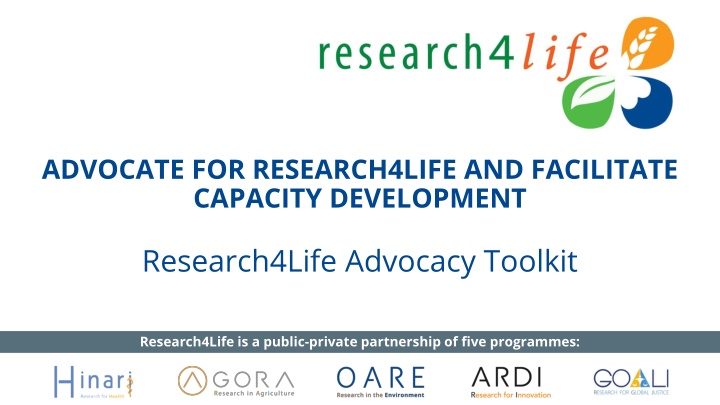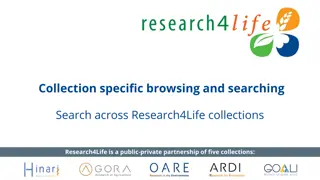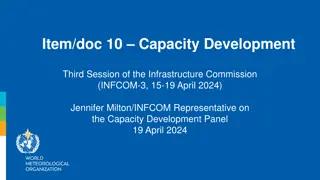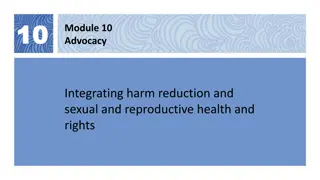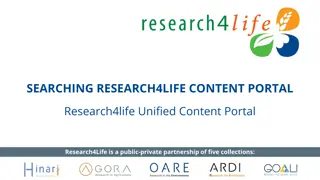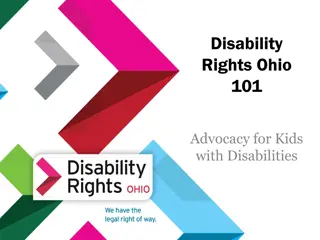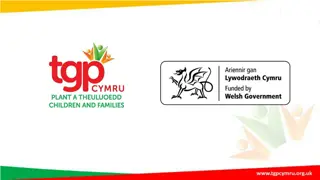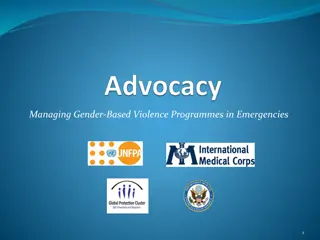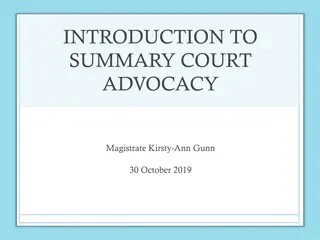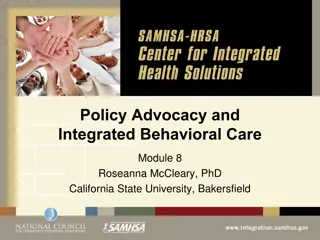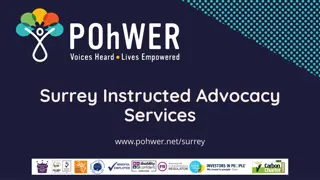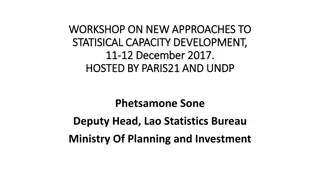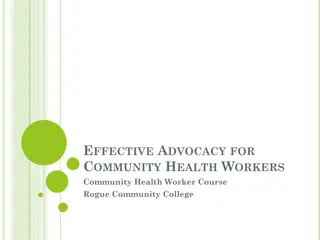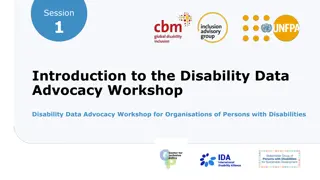Advocacy and Capacity Development in Research4Life
Research4Life is a public-private partnership offering programs to enhance access to scientific knowledge. The Advocacy Toolkit emphasizes the importance of advocacy in influencing decision-makers and stakeholders. It provides strategies for successful advocacy, including identifying challenges, setting goals, and engaging target audiences. Advocacy in the context of libraries is highlighted as a strategic and ongoing process to raise awareness and build support. The toolkit promotes sharing and adapting materials under Creative Commons licensing.
Download Presentation

Please find below an Image/Link to download the presentation.
The content on the website is provided AS IS for your information and personal use only. It may not be sold, licensed, or shared on other websites without obtaining consent from the author.If you encounter any issues during the download, it is possible that the publisher has removed the file from their server.
You are allowed to download the files provided on this website for personal or commercial use, subject to the condition that they are used lawfully. All files are the property of their respective owners.
The content on the website is provided AS IS for your information and personal use only. It may not be sold, licensed, or shared on other websites without obtaining consent from the author.
E N D
Presentation Transcript
ADVOCATE FOR RESEARCH4LIFE AND FACILITATE CAPACITY DEVELOPMENT Research4Life Advocacy Toolkit Research4Life is a public-private partnership of five programmes:
Outline Introduction Definition of advocacy Steps for a successful advocacy strategy Step 1: Identify the challenge you face Step 2: Setting up specific goals and objectives Step 3: Identifying and analysing your target audience Step 4: Mapping out resources and capabilities Step 5: Developing a strategic plan and activities Step 6: Monitor and evaluate the results Other activities Summary v1.0 April 2020 This work is licensed under Creative Commons Attribution-ShareAlike 4.0 International (CC BY-SA 4.0)
Learning objectives Make a case for their upper management to obtain institutional Research4Life membership Present benefits of the Research4Life programmes to various key constituencies, including library management
Introduction The materials in the Research4Life Advocacy Toolkit uses the Creative Commons International (CC BY SA 4.0) license. Attribution-ShareAlike 4.0 Users can share (copy and redistribute the material in any medium or format) and adapt this material (remix, transform and build upon the material for any purpose, even commercially). Research4Life Advocacy Users are required to give attribution (give appropriate credit, provide a link to the license and indicate if changes have been made) and use the same license in any revised document.
Advocacy defined According to UNICEF: Advocacy is the deliberate process, based on demonstrated evidence, to directly and indirectly influence decision-makers, stakeholders and relevant audiences to support and implement actions that contribute to enhanced access to scientific knowledge.
Advocacy in the context of a library Advocacy is the ongoing process of building partnerships so that others will act for and with you, turning passive support into educated action for the library media program. Advocacy is a planned, deliberate, sustained effort to raise awareness of an issue. It's an ongoing process in which support and understanding are built incrementally over an extended period of time Source: http://www.ala.org/aasl/advocacy/definitions , accessed 29 April 2020
Librarians as advocates Librarians are increasingly acting as advocates for their resources and services. Advocacy can improve the visibility of libraries and get the message out to larger communities about what the modern library is and does. Advocacy can also help librarians become part of larger local, regional, or national conversations. Advocacy requires the staff to move out of the library and into the community to promote services and resources and connect with partners, stakeholders and supporters.
Research4Life Advocacy Toolkit Research4Life has developed an Advocacy Toolkit to support librarians advocacy activities. The Research4Life Advocacy Toolkit, a practical instrument that provides a range of resources to get support from decision-makers, administration or management to promote the academic library and the Research4Life programmes. The full toolkit has practical exercises that help individuals create advocacy strategies for specific libraries. The Research4Life Advocacy Toolkit is available at https://www.research4life.org/training/other-resources/ Note: The Advocacy Toolkit is different than the development of a marketing plan that is aimed at users and reviewed in Lesson 5.2"
Some examples from the field Mary Acanit (Uganda) advocated for Kyambogo University to link to the Research and Education Network for Uganda (RENU), which aims to connect all Ugandan universities, colleges, and research institutions via an affordable country- wide high-speed network backbone for cheaper and faster access to global research resources. Alice Matimba s (Zimbabwe) team successfully advocated for a health policy that has transformed the care and treatment for patients with diabetic retinopathy and other eye complications. Lui Philip Kame (Papua New Guinea), a Technical Services Librarian at the PNG University of Natural Resource and Environment in Port Moresby, Papua New Guinea, developed a solution himself: a mini-ICT networking system that provides online services for the library to complement its traditional over-the-counter services
Steps for a successful advocacy strategy The steps are: Identify the challenge Note types of advocacy efforts Understand Research4Life and identify Research4Life resources Set up specific objectives Analyze the audience Map out resources and capabilities Develop a strategic plan and activities Monitor and evaluate results
Advocacy efforts The toolkit reviews some examples of advocacy efforts such as; Collecting evidence: gathering data or conducting surveys about your library Attending professional development: following a course or training Being a member of association or task force Communicating with decision-makers Attending faculty or staff meetings Attending conferences and giving presentations Collaborating and networking with other librarians
Activity 1 Can you identify and list other types of advocacy efforts ?
Activity 2 What can your library offer? Make a list of the available e-resources and describe the benefits of each.
Examples of possible situations in a library a) An institutional library would like to access the resources in the five Research4Life programmes, but it is situated in a Group B country. The library has to secure funding for the annual fee of 1500 USD An institution has provided its members with free access to scientific knowledge through Research4Life for years, but now the country has been reclassified to group B. The institutional members have to convince their management to pay the 1,500 USD annual fee. The librarians of an institution that is subscribed to Research4Life notice that their institutional members are not aware of the resources that Research4Life provides. The staff needs to raise awareness about the resources. To organize training, they need funding and support from their management. A library would like to make more use of Research4Life but is lacking technical equipment to provide access to the resources. They need to convince their institutional management to invest in infrastructure or look for other ways of funding. b) c) d) e)
Step 1: Identify the challenge you face Before starting to plan the advocacy strategy, it is important that the planners ask several questions that will help them to shape the efforts in the best way. It is also important to identify problems and opportunities. What is the problem you are trying to solve?
Activity 3 Is one of the above examples your case? If not, can you describe the problem you are trying to solve in a clear statement?
Step 2: Setting up specific goals and objectives Now that the problem has been identified, the staff needs to develop the main/broader goal(s) and a series of (specific, measurable, attainable and realistic) objectives. What is the main goal you aim to achieve? What are the long and short-term objectives that build towards your goal?
Activity 4 List the Advocacy and goal(s) and specific objective(s)
Step 3: Identifying and analysing your target audience Once the staff has identified the problem and outlined goals and objectives, they need to identify the advocacy target audiences. Make a list of the target audiences so the staff can work out how to influence them. Who is your target audience?
Activity 5 Who is your target audience? List the different types of audiences you are trying to reach and provide a brief description of them
Step 4: Mapping out resources and capabilities Numerous resources are available from the Research4Life website or specific programme training pages. Research4Life resources include a PowerPoint presentation for advocacy, factsheets and infographics, posters, case studies, interviews, and videos. Also remember that the institution s communications department can help.
Activity 6 List the resources that your library has and the ones that you can develop yourself to help your advocacy strategy
Step 5: Developing a strategic plan and activities This is the step where planning is converted into effective activities. Different communication and marketing tools can be combined or just use one that meets your needs. A number of potential activities are listed below: Organize open library events and invite administrators to attend Using the Research4Life Advocacy PowerPoint presentation, make presentations to a faculty, student, research or management groups conduct interviews to gather testimonials on the use and impact of Research4Life resources. Please Note: the complete Advocacy Toolkit has more details about these possible activities
Activity 7 List the activities for the Strategic Plan
Step 6: Monitor and evaluate the results To monitor the project s progress, the planners should evaluate each objective at regular intervals. If they find that one objective progresses more slowly than the others, the activities for that objective may be ineffective and may need to be changed. Below are several examples of evaluation tools for certain objectives: Open events: How many people attended? Were they satisfied with the event? You can conduct a small satisfaction survey to hand out at your library event. Interviews: Did you gather the intended data you wished to obtain? If not, why not? Social media: What were your specific objectives for this activity? Likes? Engagement? Or simply setting up social media accounts?
Activity 8 List the activities and the describe the evaluation methods for each
Other activities For the final exercise, the objective is to develop a year-long plan: a calendar of 52 weeks of tools and activities for advocacy in the library Activity: Write down a mix of tools and activities you wish to implement for your communication strategy and organize them in a calendar.
Summary This lesson focused on using the Research4Life Advocacy Toolkit to develop an advocacy strategy for a library. Initially focused on Group B institutions and the need to obtain funds for the annual fee, the plan is useful for all institutions that use or plan to use Research4Life. Advocacy can improve the visibility of the library and raise awareness about the resources. The exercises in the Toolkit will help with the development of a plan for an institution based on the goals and objectives for a specific situation.
You are invited to; Visit us at www.research4life.org Contact us at r4l@research4life.org Find out about other training materials [www.research4life.org/training] Subscribe to Research4Life newsletter [www.research4life.org/newsletter] Check out Research4Life videos [https://bit.ly/2w3CU5C] Follow us on Twitter @r4lpartnership and Facebook @R4Lpartnership
For more information on Research4Life www.research4life.org r4l@research4life.org Research4Life is a public-private partnership of five programmes:
